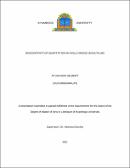| dc.description.abstract | This study examined how Hollywood Jesus films adapt Jesus and the biblical records into motion pictures and the intricacies of transforming the Bible; a sacred written text to many into a cinematic version. The study was inspired by the films’ persistent claim to biblical and historical accuracy which has placed them beyond question and have ultimately been used as reliable mediums of references to biblical truth on one hand, and evangelism tools on the other. Five Jesus films; The King of Kings (1927), Jesus Christ Superstar (1973), Jesus of Nazareth (1977), The Passion of Christ (2004), and Killing Jesus (2015) were purposively selected from different periods ranging from the silent era of the 1820s to the 21st-century high definition 3D motion pictures to facilitate a holistic analysis from differentiated perspectives. Using document analysis, the films were analyzed in comparison with the Bible primarily the gospels to evaluate and validate claims of biblical authenticity, through critical reading, interpretation, and analysis of the literary and cinematic forms of gospel representations. The undertaking was informed by Jacques Derrida’s (1967) deconstruction theory under the premise that there is no single meaning to a text rather various interpretations and viewpoints of different readers. Findings of the study suggested that Jesus film adaptations are fictional re-enactments and watching them expecting to realize a comprehensive understanding of the Bible is a blunder. The adaptations were found to be unfaithful to the Bible due to the formal difference between the literary and cinematic forms and the limitations of changing words into images. Chapter one of the study provided the background on the historical relationship between the Bible, Jesus film adaptations, and the interplay between the two forms of expression. It highlighted Hollywood’s interest in classical texts including the Bible. Consequently, it provided the statement of the problem, literature review, research questions, and significance of the study. Chapter two investigated the distinct nature of the biblical Jesus and Hollywood Jesuses while chapter three examined the challenges and limitations of transforming the Bible into film. Chapter four unpacked the implication of Jesus films on the Christion doctrine while chapter five synthesized the findings of the study and suggested some recommendations. | en_US |

